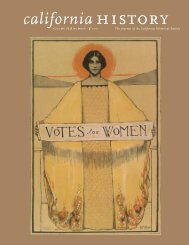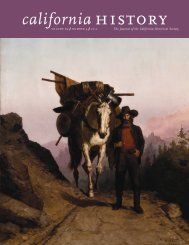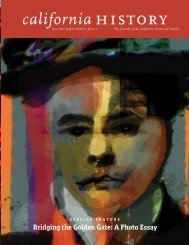Volume 90, Number 1 - California Historical Society
Volume 90, Number 1 - California Historical Society
Volume 90, Number 1 - California Historical Society
You also want an ePaper? Increase the reach of your titles
YUMPU automatically turns print PDFs into web optimized ePapers that Google loves.
At times, an expedition was the consummate<br />
exercise whereby soldiers and militia repented of<br />
their sins and, at least for the moment, restored<br />
their place in the Christian community. In 1828,<br />
Sergeant Sebastian Rodríguez reported that during<br />
the hunt for fugitive converts, the soldiers<br />
twice heard Mass. 81 The most sacred ceremony<br />
of the Catholic faith requires believers to confess<br />
their sins. According to the Latin Rite, which<br />
would be the liturgy followed by the residents of<br />
<strong>California</strong>, the congregation prays, “I have sinned<br />
exceedingly in thought, word, and deed, through<br />
my fault, through my most grievous fault.” After<br />
the priest asks that “the Almighty and Merciful<br />
Lord grant us pardon . . . and [the] remission of<br />
our sins,” any person who wishes could receive<br />
Communion, and once more sit at the Lord’s<br />
table. 82 Even Indians taken prisoner during these<br />
expeditions received the chance to repent. In<br />
1837, José María Amador of San Jose led “soldiers<br />
and civilians” into the Central Valley to recover<br />
stolen horses. Of the two hundred Indians captured<br />
by the party, one hundred were fugitive<br />
neophytes, with the remainder being gentiles, or<br />
“heathen.” Amador told the Christian Indians<br />
to “pray the creed.” In other words, they could<br />
renounce sin by professing their faith. He then<br />
ordered their execution with “two arrows in the<br />
front and two in the back.” To make sure that the<br />
pagan Indians did not die in a state of sin, Amador<br />
“baptized” them and commanded his men to<br />
shoot the prisoners “in the back.” 83<br />
In the end, the way the priests and settlers used<br />
violence testifies to connections that span generations.<br />
Muslims in Spain conveyed certain practices<br />
to their Christian rivals, who then passed<br />
them to the settlers and colonists of the New<br />
World. Although rendered into Christian form,<br />
the Muslim ideas of jihad and ribat nonetheless<br />
possessed some of their original shape and intent.<br />
In some instances, war became a pilgrimage in<br />
which the warrior performed penance, and thus<br />
obtained the opportunity to fight his way into<br />
Like Spanish Christians<br />
centuries before, <strong>California</strong>’s<br />
warriors believed that for<br />
the duration of their quest,<br />
the slaying of enemies<br />
would serve as penance or<br />
professions of worship.<br />
paradise. But if war is an act of faith, there come<br />
beguiling questions. Did the residents of <strong>California</strong>,<br />
like their predecessors in Spain, use religion<br />
to justify war? Or did they really think war was a<br />
form of religious expression? The answer to these<br />
questions depends on the reader’s approach to<br />
faith. But even so, the association of war with a<br />
pilgrimage addresses contemporary concerns.<br />
When one reads about Muslim militants invoking<br />
God to justify violence, or remembers that in<br />
2003 an American president said that war would<br />
usher in a “New Age” and fulfill biblical prophecies,<br />
the priests and settlers of <strong>California</strong> sound<br />
quite modern. 84 They are not, then, a remote<br />
populace lost to us through time and distance;<br />
rather, in their use of war they behaved as we do,<br />
sometimes repelled, sometimes emboldened, but<br />
all the while fascinated by the clarion call to muster<br />
ranks and fight.<br />
Michael Gonzalez is an associate professor of history at<br />
the University of San Diego. He teaches <strong>California</strong> history,<br />
Chicano history, Cold War history, and Middle Eastern history<br />
and terrorism. He also is the director for the history master’s<br />
program.<br />
39









